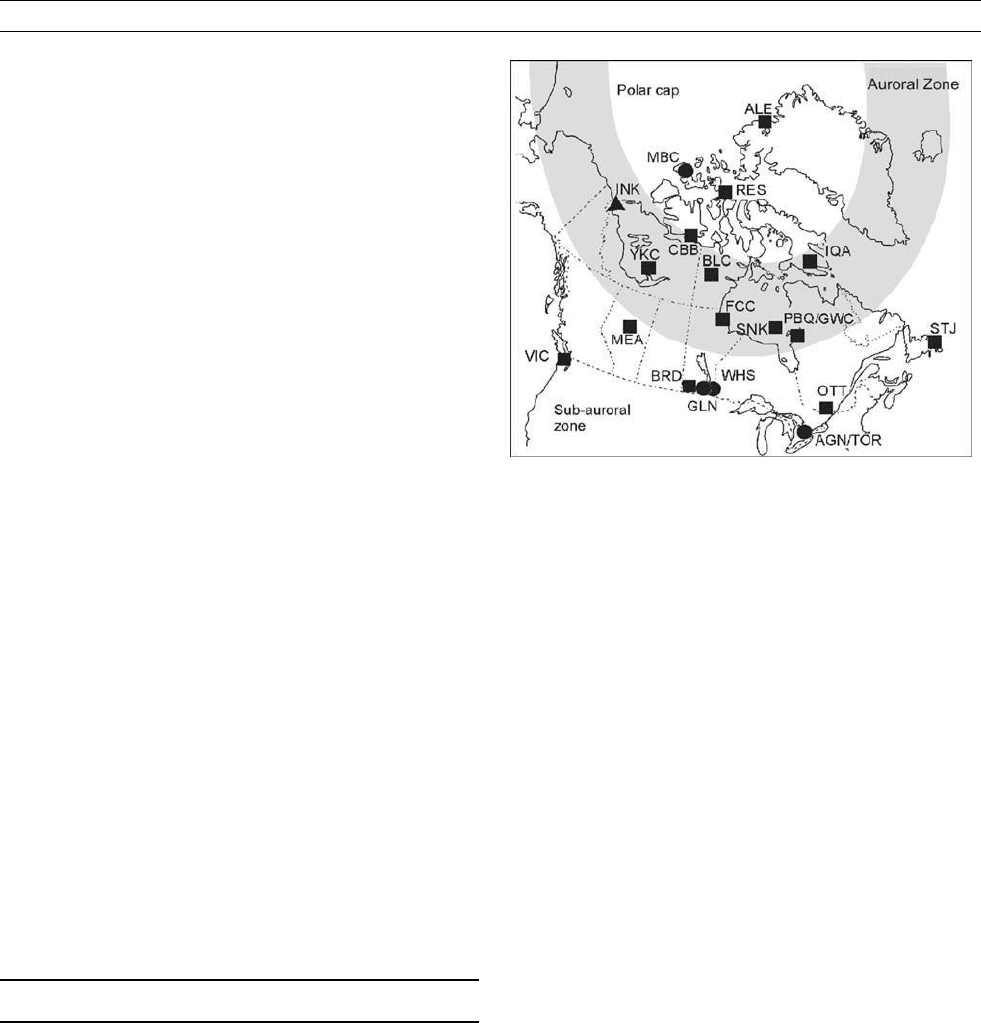Gubbins D., Herrero-Bervera E. Encyclopedia of Geomagnetism and Paleomagnetism
Подождите немного. Документ загружается.


Dutch customers involved in aeronautical and topographic mapping
continued to request declination information over the Netherlands after
the closure of the Dutch magnetic service so that from 1999 onward,
the team from DOU performs yearly repeat measurements at several
Dutch stations, including former Witteveen Observatory, for producing
the isogonal maps.
Future perspect ives
The Belgian observatories DOU and MAB will remain open for the fore-
seeable future—especially as there is demand from the socioeconomic
sector for magnetic products and services in the Benelux. There is a
search going on for a new site in Belgium with reduced noise, espe-
cially as space weather research and forecasts needs clean short period
signals.
There are no plans in the Netherlands to resume the operation of
Witteveen Observatory. The TNG Observatory is in need of a better
observation site and improved instrumentation; international collabora-
tion with the Indonesian Meteorological and Geophysical Agency is
attempting this now.
There are talks between the Democratic Republic of Congo and
Belgium to resume operation in Binza, whose magnetic pavilions are
reported to be in good condition. A new Belgian Antarctic base might
also host a magnetic observatory 200 km south of RBD as part of a
contribution to the IPY in 2007–2008.
Jean L. Rasson
Bibliography
Flick, J.A., and Stomp, N., 2002. Sciences de la Terre au Luxem-
bourg—Réminiscences. Luxembourg: Musée National d’Histoire
Naturelle et ECGS.
Schreutelkamp, F.H., 2001. Het aardmagnetische veld ontrafeld. Zenit,
28: 136–141, 186–190.
De Vuyst, A., 1962. La variation de la Déclinaison Magnétique en
Belgique de 1828 à 1960.5. Contributions de l’Institut Royal
Météorologique de Belgique, 68.
Cross-references
Bemmelen, Willem van (1868–1941)
Geomagnetism, History of
Observatories, INTERMAGNET
OBSERVATORIES IN CANADA
The origin of the Canadian Magnetic Observatory Network (CANMON)
can be traced backto the founding of the Toronto Magnetic Observatoryin
1839. Except for a few temporary magnetic observatories, such as those
established during the First International Polar Year (1882–1883), Tor-
onto (later Agincourt) was the only magnetic observatory operating in
Canada until 1916, when Meanook was established. The network grew
substantially during the years preceding and following the International
Geophysical Year (1957–1958) and now consists of 13 observatories,
operated by the Geological Survey of Canada, Natural Resources
Canada (GSC).
Distribution of observatories
The CANMON extends over 40
of magnetic latitude, from 54.3
N
to 86.4
N, and includes three zones of differing magnetic activity:
subauroral, auroral, and polar cap. The distribution of observatories
relative to the three zones is shown in Figure O12. All observatories,
including those that are no longer in operation, are listed in Table O2.
Inuvik should be in operation by 2007.
Although the stations shown in Figure O12 are the only true mag-
netic observatories in Canada, several other magnetic variometer net-
works have been established to measure the unusual magnetic
conditions that result from the presence of the polar cap and auroral
zone. These include the CANOPUS (now CARISMA) network, the
MACCS network, and the THEMIS network, as well as several other
minor networks and single stations. In all, more than 80 permanent or
semipermanent magnetometers are currently operating in Canada.
Instrumentation
All magnetic observatories in the CANMON except Alert are part of
INTERMAGNET and are operated to INTERMAGNET standards
(see Observatories, INTERMAGNET ). Each observatory is equipped
with CANMOS (Canadian Magnetic Observatory System), a modular
system whose various components are controlled by a desktop PC, which
also serves as the data-acquisition system. The system is equipped with
two magnetometers: a three-component ring-core fluxgate for recording
variations in the X (north), Y (east), and Z (vertical) components, and an
Overhauser magnetometer for recording total intensity. The sensor of
the three-component magnetometer is mounted on a novel tilt-compensat-
ing suspension (Trigg and Olson, 1990), and both sensor and electronics
are housed in a temperature-controlled enclosure to minimize drift. The
system transmits 1-min data via the GOES satellite to downlinks located
at Ottawa and Golden, Colorado. At some observatories, 1-s data are
transmitted in real time via the Internet. The system is also accessible
via telephone modem, allowing remote monitoring and diagnosis of any
problems.
Each observatory is also equipped with a declination-inclination
magnetometer (DIM), consisting of a steel-free theodolite equipped with
a single-axis fluxgate sensor used for weekly absolute observations.
Data availability
Both preliminary and definitive data are available, filtered over the fol-
lowing intervals: 1 s, 5 s, and 1 min. Definitive data undergo rigorous
quality control and are calibrated using information derived from the
DIM and Overhauser magnetometers. Preliminary data are checked for
major spikes only. Preliminary 1-min data are available within 24 min.
For those observatories that transmit data via the Internet, the delay
Figure O12 Distribution of Canadian observatories: currently
operating (large squares); closed (circles); planned (triangle).
726 OBSERVATORIES IN CANADA

is at most a few minutes. Minute data may be plotted and down-
loaded from either the GSC Geomagnetic Laboratory’ s Web site
(www.gsc.nrcan.gc.ca/geomag/) or from the INTERMAGNET site
(http://www.intermagnet.org).
One- and 5-s data that are transferred in real time are available
almost instantly from the geomagnetic laboratory site. They are also
available from the Canadian Geospace Monitoring Program data portal
(ssdp.ca). Definitive data are normally available about 3 months after
year’s end. They replace the preliminary data at all sampling intervals
on all the above-mentioned Web sites. In addition, 1-min definitive
data are available on the INTERMAGNET CD and from World Data
Center Web sites.
Innovation
Magnetic observatories must evolve and adapt to meet the needs of the
scientific community that they serve. In addition to this scientific
imperative, development of the CANMON has been influenced by
the logistical, environmental, and economic challenges brought about
by the remoteness of many sites in this vast network. The presence
of the auroral zone and the proximity of the north magnetic pole also
present challenges in instrument design. These factors have provided
impetus for innovation. Many instrumental and procedural develop-
ments that are now considered common place were pioneered or
quickly adopted for use in CANMON. Most notable were the use of
the DIM as an absolute instrument, which began in the mid-1950s
(Serson and Hannaford, 1956; Loomer, 1961) and the development
of a semiautomated, digital network, which began in 1969 with the
installation of the AMOS system at St. John’s (Delaurier et al., 1974).
Lawrence R. Newitt and Richard Coles
Bibliography
Delaurier, J.M., Loomer, E.I., Jansen van Beek, J., and Nandi. A., 1974.
Editing and evaluating recorded geomagnetic components at Cana-
dian observatories. Publication of the Earth Physics Branch, 44(9):
235–242.
Loomer, E.I., 1961. Record of observations at Resolute Bay Magnetic
Observatory 1957–1956 with a summary of earlier observations.
Publications of the Dominion Observatory, 34(2): 25–131.
Serson, P.H., and Hannaford, W., 1956. A portable electrical magnet-
ometer. Canadian Journal of Technology, 34: 232–243.
Trigg, D.F., and Olson, D.G., 1990. Pendulously suspended magnet-
ometer sensors. Review of Scientific Instruments, 61: 2632–2636.
Cross-references
Observatories, Automation
Observatories, INTERMAGNET
Observatories, Overview
OBSERVATORIES IN CHINA
At present, there are 43 magnetic observatories in China’s mainland.
Forty of them are sponsored by the China Earthquake Administration
(CEA), formally China Seismological Bureau (CSB) and State Seis-
mological Bureau (SSB). Three others are sponsored by the Institute
of Geology and Geophysics, Chinese Academy of Sciences
(IGGCAS), formally the Institute of Geophysics, Chinese Academy
of Sciences (IGCAS). Among the 40 sponsored by the CEA, 3 new
ones are under construction and are expected to operate in 2007. All
of the CEA observatories will be equipped with at least two sets of
triaxial fluxgate magnetometers, one fluxgate theodolite, and one pro-
ton precession magnetometer in 2007. For the most important observa-
tories, an additional fluxgate theodolite and continuous recording of
total field by the Overhauser effect magnetometer will also be
deployed.
History
There were four major periods for the development of the magnetic
observatories in China’s mainland.
Table O2 Canadian magnetic observatories
Name IAGA code Geographic Geomagnetic First year Status
Alert ALE 82.497 297.647 86.89 23.2 1961 Operating
Mould Bay MBC 76.315 240.638 79.90 275.2 1962 Closed, 1995
Resolute Bay RES 74.690 265.105 82.90 302.9 1952 Operating
Cambridge Bay CBB 69.123 254.969 76.53 303.0 1972 Operating
Baker Lake BLC 64.318 263.988 73.17 322.1 1951 Operating
Iqaluit IQA 63.753 291.482 73.99 5.2 1994 Operating
Yellowknife YKC 62.820 245.518 69.25 299.0 1975 Operating
Fort Churchill FCC 58.759 265.912 67.94 328.4 1957 Operating
Poste-de-la-Baleine
(Great Whale River)
PBQ GWC 55.277 282.255 65.46 351.8 1967 Operating, will close
2007 (relocated, 1985)
Sanikiluaq SNK 56.536 280.769 67.23 350.6 2006 Replaces PBQ
Meanook MEA 54.616 246.653 61.57 306.2 1916 Operating
Brandon BRD 49.875 260.025 58.60 324.2 2006 Operating
Glenlea GLN 49.645 262.880 58.66 327.6 1982 Variometer since 1997;
closed 2005
Whiteshell WHS 49.700 264.75 58.89 330.1 1976 Closed, 1980
Victoria VIC 48.420 236.580 54.04 297.6 1956 Operating
St. John’s STJ 47.595 307.323 57.15 24.0 1968 Operating
Ottawa OTT 45.403 284.448 55.64 355.3 1968 Operating
Agincourt (Toronto) AGN TOR 43.783 280.733 53.94 350.8 1839 Closed, 1968
(relocated 1899)
OBSERVATORIES IN CHINA 727

Before the International Geophysical Year (IGY)
1957–1958
The first magnetic observatory in China was constructed in Beijing in
1870 by Russia. It ceased working in 1882. There had been other six
magnetic observatories with different periods of operation but all of
them had ceased working before 1944. One exception was Sheshan
(SSH) Observatory which was constructed in 1874 by French mission-
aries and is still in operation now.
During the IGY
During the IGY, construction of seven magnetic observatories includ-
ing Beijing (BJI), Changchun (CNH), Wuhan (WHN), Guangzhou
(GZH), Lanzhou (LZH), Lhasa (LSA) and Urumqi (WMQ) observa-
tories was initiated. Together with SSH, these eight observatories
became the backbone of the Chinese magnetic network.
From 1966 to 1979
The 1966 Xingtai Earthquakes triggered the beginning of the Chinese
research on earthquake prediction. Various observation methods were
utilized including magnetic observation. More than 200 magnetic
stations were set up around the country in the following years.
These stations were sponsored by different organizations and/or insti-
tutions with a variety of observational procedures and quality controls.
After 1979
In 1979, all of the magnetic observatories and stations were put under
the administration of the SSB. An organization (now the Geomagnetic
Network of China) in the Institute of Geophysics, SSB (IGSSB, now
IGCEA) was responsible for the technical support and data manage-
ment of the magnetic network. The network was readjusted several
times taking into account the distribution and the observational envir-
onment of the stations. Half of the stations ceased working. Mean-
while, instrumentation at 29 of the stations was improved to make
them operate as observatories. Later on, three other observatories were
set up in Mohe (1989), Beijing Mingtomb (BMT, 1993), and Sanya
(1995) by the IGCAS (now the IGGCAS).
Activities
All of the existing observatories have been producing yearbooks,
K-indices, and catalogs of magnetic storms. The Geomagnetic Net-
work of China is in charge of the quality control and dissemination
of the data from the CEA observatories. These magnetic observations
have been widely used in research work and applications related to
geomagnetic field.
The relatively short distances among the observatories have had
advantages. For example, the detection of errors in data by using
the method of interobservatory comparison is justifiable if the
observatories are close together. It also helps the scientists in research
work on earthquake prediction and regional characteristics of the
magnetic field.
Data from more than 15 observatories have been archived in the World
Data Center system. Some of the observatories have been participating in
international projects such as the Sino-American, Sino-Japanese, and
Sino-French projects. Three observatories have participated in INTER-
MAGNET (see Observatories, INTERMAGNET). With the improve-
ment of the instrumentation at the observatories, it is believed that there
will be more INTERMAGNET magnetic observatories from China’s
mainland in the near future.
Dongmei Yang
Cross-reference
Observatories, INTERMAGNET
OBSERVATORIES IN EAST AND
CENTRAL EUROPE
The first systematic magnetic observations in Central and Eastern Eur-
ope were made in Prague in 1839 by Karl Kreil (1798–1862), who
was assistant director, and from 1845 director of the Prague Observatory
and professor of astronomy at the Prague University. Measurements of
declination started in 1830. Kreil constructed and improved magnetic
instruments (using, among others, Gauss’s method of measuring the
horizontal component) and organized a rational system of magnetic
observations. From 1843 he also carried out a magnetic survey of the
Austrian Empire. In 1851, he was appointed the first Director of
the Central Institute of Meteorology and Geomagnetism (ZAMG) in
Vienna. The geomagnetic observatory started operating there in 1852.
The first Hungarian magnetic observatory was founded in Buda in
1871, but had to be closed in 1889 due to increased industrial activity,
which rendered the measurements unreliable. The magnetic observa-
tions continued in O’Gyalla under the auspices of the Royal Hungarian
Meteorological Institute. The geomagnetic observatory at O’Gyalla was
officially opened in 1900. The observatory was a witness of the turbu-
lent political development in Central Europe. Whereas many observa-
tories had to change their locations due to industrial noise, O’Gyalla,
having kept its original location, changed its name twice (Stará Ďala
in 1924 and Hurbanovo in 1948) and the country it belonged to five
times. In spite of this, Hurbanovo (IAGA code HRB) is the oldest oper-
ating observatory in Central and Eastern Europe.
Another geomagnetic observatory was established in 1880 in Pola
(Istria Peninsula) under the auspices of the Hydrographical Institute
of the Austro-Hungarian Imperial and Royal Navy. The data were also
used for reducing Italian magnetic surveys. The observatory was in
operation till 1925.
Before World War I, magnetic observations were made at several
other places, but the operation was usually short (less then 10 years)
and the only measured element was declination. Five observatories
were founded between the wars: Swider near Warsaw (1920, SWI)
and Hel (1932, HLP) in Poland, Wien Auhof (1929, WIA) in Austria,
Jassy (1931, JSS) in Romania, and Panagyurishte (1937, PAG) in Bul-
garia. On the other hand, Prague Observatory, located in the city center
since 1839, was finally closed down in 1926.
The present shape of the observatory network was formed after
World War II in a climate of increased interest in geosciences, also
supported by the International Geophysical Year in 1957/1958. Due
to the growth of industrial and urban magnetic noise more attention
was paid to the choice of the sites. Of course, it was not easy to foresee
future development. As regards the older observatories, only Hel,
Hurbanovo, and Panagyurishte were able to keep their original sites.
The Vienna Observatory was moved in 1955 from Auhof to Wien
Kobenzl (WIK). As this location is also not perfect, transfer to a qui-
eter place is being considered. The Prague Observatory was replaced
in 1946 by Pruhonice near Prague (PRU) but rapid expansion of the
city and construction of DC-powered railways resulted in a deteriora-
tion of this location. The observatory was moved to Budkov (BDV)
in south Bohemia, to a sparsely populated area, in 1967. Two observa-
tories were built in Hungary. The Tihany (THY) Observatory was
founded in 1953 in a protected area on the northern shore of Lake
Balaton. The tourism boom brought more traffic to this area than
had been expected; nevertheless, the conditions are still satisfactory.
Another observatory was built in 1956–1957 in Nagycenk (NCK) near
Sopron. Although the primary aim of the observatory was for the study
of the Earth’s electromagnetic field of external origin, it produces stan-
dard geomagnetic data. The Swider Observatory was affected by mag-
netic noise from Warsaw. An appropriate location was found in a rural
region about 50 km south of Warsaw in Belsk (BEL) and regular mea-
surements started in 1965. The Institute of Geophysics of the Polish
Academy of Sciences has also been operating the Hornsund (HRN)
Observatory in Spitsbergen since 1978. The Romanian observatory,
728 OBSERVATORIES IN EAST AND CENTRAL EUROPE

Surlari (SUA), was established in 1943 north-east of Bucharest. The
Serbian observatory, Grocka (GCK), began its operations during the
International Geophysical Year in 1957.
Most of the observatories joined the INTERMAGNET network
(number in brackets shows the first year the data were presented on
INTERMAGNET CD-ROM): Tihany (1991), Belsk (1993), Nagycenk
(1993), Budkov (1994), Hurbanovo (1997), Hel (1998), Surlari (1999),
and Hornsund (2002).
Two research groups are active in geomagnetic instrumentation
development. Torsion photoelectric magnetometers (TPM), based on
Bobrov-system quartz variometers, are being constructed in Belsk
since 1977. In these magnetometers, angular deflections of variometer
magnet mirrors are converted, by means of photoelectric convertors,
into electric voltage changes in a system with a strong negative feed-
back. The Tihany Observatory is developing digital data acquisition
systems DIMARS and DIMARK. They are designed for geomagnetic
observatories to measure and process output signals of vector fluxgate
and Overhauser proton precession magnetometers according to
INTERMAGNET standards.
Pavel Hejda
Cross-reference
INTERMAGNET
OBSERVATORIES IN GERMANY
Introduction
The tradition of geomagnetic observations in Germany spans back to the
16th century. In the early beginning, only the declination was observed
for the purposes of navigation and mining by means of compasses. Dur-
ing the 19th century the theories and measurement methods of geomag-
netic intensities were developed in Germany by Gauss and Weber.
The first “real” magnetic observatories in Germany were established
by Gauss and Weber in Göttingen; by Alexander von Humboldt in
Berlin and by Johann von Lamont in Munich. Today, three geomagnetic
observatories are in operation in Germany: Fürstenfeldbruck, Niemegk,
and Wingst, which all participate in the worldwide INTERMAGNET
network. Table O3 includes essential information about the German
observatories.
Development and international contribution
Early time series may be reconstructed from the notations by mining engi-
neers or sailors, inscriptions in old instruments and maps, and by correct-
ing these series with more recent observations. In Knothe (1987), the
declination observation series of Krakau (today Krakow, Poland), Danzig
(today Gdansk, Poland), Freiburg, Munich, and Clausthal are plotted
together with those of Prague, Böckstein (Austria), Copenhagen, Paris,
and London. Of course, these series are affected with large uncertainties,
but they are the earliest certificates of magnetic observations in Germany.
The German universal scientist Alexander von Humboldt (1769–
1859) initiated from 1827 onward with own studies and by inspiring
others progress in terrestrial magnetism in Germany. The mathematician
Carl Friedrich Gauss (1777–1855), inspired by Humboldt, formulated
the general theory of earth magnetism, developed the measurement
method for the absolute determination of the intensity and introduced
a system of physical units for geomagnetism from 1829 onward. When
Wilhelm Weber (1804–1891) came to Göttingen in 1831, one of the
most fruitful collaborations devoting to science started. In 1833, they
initiated the construction of a nonmagnetic house for geomagnetic
measurements in Göttingen. This magnetic observatory soon became
the center of the “Göttinger Magnetischer Verein (Göttingen Magnetic
Union).” This union, initiated by Humboldt, Gauss, and Weber, was
the first worldwide geomagnetic observatory network, which existed
from 1836 to 1841 and included 53 observatories, 18 of them non-Eur-
opean ones. All observatories took readings from their magnetometers
all 5 min during appointed days. The results were published by Gauss
and Weber together with scientific articles.
Observatories
Table O3 includes those German observatories that were in operation
for long periods, and which provided vector data of the Earth magnetic
induction vector. Table O4 shows general information about these
observatories, while Table O5 contains the used main instruments.
Summary and outlook
The German scientists Alexander von Humboldt, Carl Friedrich Gauss,
and Wilhelm Weber initiated the establishment of the first magnetic
observatories in Germany during the 1930s. They created the scientific
basements of the measurement and mathematical description of terres-
trial magnetism and developed suitable instruments. Further essential
theoretical and instrumental contributions were performed by Johann
von Lamont (1805–1879) and Adolf Schmidt (1860–1944). The
“Göttinger Magnetischer Verein” (Göttingen Magnetic Union), initiated
by Humboldt, Gauss, and Weber was the first worldwide geomagnetic
observatory network.
Due to several reasons, the first magnetic observatories (Göttingen,
Berlin, and Munich) that were established in the frame of the Göttingen
Magnetic Union do not exist any more. Industrial and urban distur-
bances forced the movement of the observatories from their first
locations within the cities to places far away from scientific centers.
Today there are three observatories Fürstenfeldbruck (successor of
Munich and Maisach), Niemegk (successor of Potsdam and Seddin),
and Wingst (successor of Wilhelmshaven). The time series span back
to 1840 (Munich-Maisach-Fürstenfeldbruck), 1890 (Potsdam-Seddin-
Niemegk), and 1878 (Wilhelmshaven-Wingst). The observatories coop-
erate closely, though they are sponsored by different scientific institutions:
Fürstenfeldbruck by the Institute of General and Applied Geophysics of
Munich University, Niemegk by the GeoForschungsZentrum Potsdam,
and Wingst by the GeoForschungsZentrum Potsdam and the Bundesamt
für Seeschifffahrt und Hydrographie Hamburg (German maritime
authority).
All three observatories produce minute, hourly, daily, monthly, and
annual mean values and K-indices. They send reported data in quasi
real-time and definitive data to INTERMAGNET. The observations
contribute in the frame of the worldwide network of magnetic observa-
tories to the database for scientific research of the Earth interior and the
Table O3 German geomagnetic observatories
Observatory Latitude (North) Longitude (East) Existence
Berlin 52.515
13.393
1836–1872
Fürstenfeldbruck 48.165
11.277
1939–
Göttingen 51.533
9.950
1833–1902
Maisach 48.200
11.260
1927–1937
Munich 48.147
11.608
1841–1925
Niemegk 52.070
12.680
1930–
Potsdam 52.380
13.060
1890–1931
Seddin 52.280
13.010
1907–1931
Wilhelmshaven 53.530
8.150
1878–1919,
1931–1936
Wingst 53.750
9.070
1938–
OBSERVATORIES IN GERMANY 729

Table O4 General information about German observatories
Observatory
Previous
station
Observation
period
Observers in charge Buildings Other observations
Berlin – 1836 –1872 J.F. Encke (1836–1865) and J.G. Galle
(1836–1872)
One nonmagnetic house at
the Berlin Astronomical
Observatory
–
Fürstenfeldbruck Munich, Maisach Operated continuously since
1937
F. Burmeister (1937–1957), K. Wienert
(1957–1978), M. Beblo (1978–2003),
and J. Matzka (2003–)
Five nonmagnetic, five
others
Seismological,
telluric currents,
and air electricity
Göttingen – 1833–1902 C.F. Gauss (1833–1855), W. Weber
(1833–1867), E. Schering (1867–1897),
and E. Wiechert (1897–1902)
One nonmagnetic house at
the Göttingen
Astronomical
Observatory
Seismological
Maisach Munich 1927–1937 F. Burmeister (1927–1937) One nonmagnetic hut and
use of brewery basement
Seismological,
telluric currents,
and air electricity
Munich – 1836–1925; observing gaps
of several years
J. v. Lamont (1836–1879), C. Feldkirchner
(1879–1886), F. Schwarz (1898–1902),
J.B. Messerschmitt (1902–1912),
F. Bidlingmaier (1912–1914),
Lutz (1914–1919), and F. Burmeister
(1919–1925)
Three nonmagnetic houses
at the Munich
Astronomical
Observatory
Seismological,
telluric currents,
and air electricity
Adolf Schmidt
Observatory
Niemegk
Potsdam, Seddin Operated continuously since
1930, with a short break of
nine months 1945/1946
A. Nippoldt (1930–1936), R. Bock (1936–1939),
G. Fanselau (1939–1968), H. Schmidt
(1969–1979), K. Lengning (1980–1982),
A. Best (1983–1998), and H.-J. Linthe (1999–)
Seven nonmagnetic houses
and 10 others
Telluric currents
Potsdam – 1890–1931 M. Eschenhagen (1890–1901), A. Schmidt
(1901–1927), and A. Nippoldt (1927–1931)
Two nonmagnetic houses –
Seddin Potsdam 1907–1931 A. Schmidt (1901 –1927) and A. Nippoldt
(1927–1931)
Two nonmagnetic houses,
one other
–
Wilhelmshaven – 1878– 1919;
1931–1936
C. Börgen (1878–1909), F. Bidlingmaier
(1909–1912), and P. Meier (1931–1936)
One nonmagnetic house Meteorological and
hydrographical
observations
Wingst Wilhelmshaven 1938– O. Meyer (1938–1954), D. Voppel (1954–1974),
G. Schulz (1974–2004), and H.-J. Linthe
(2004–)
730 OBSERVATORIES IN GERMANY

solar terrestrial relations. The Adolf Schmidt Observatory, Niemegk
is further responsible for the repeat station measurements and the
construction of magnetic maps of Germany. Niemegk Observatory
further carries out the Kp service for the International Service of Geo-
magnetic Indices of the IAGA. Niemegk and Wingst are Kp stations.
Hans-Joachim Linthe
Bibliography
Knothe, C., 1987. Secular variations of the magnetic declination in
middle Europe during the last 500 years, derived mostly from mine
surveying. In Proceedings of the IAGA-Symposium Space-Time-
Structure of the Geomagnetic Field. HHI-Report No. 21 (1987),
Berlin, pp. 90–98.
Neunhöfer, H., Börngen, M., Junge, A., and Schweitzer, J., (eds), 1997.
Zur Geschichte der Geophysik in Deutschland Jubiläumsschrift
Deutsche Geophysikalische Gesellschaft 1922–1997, Hamburg:
Deutsche Geophysikalische Gesellschaft.
Schroeder, W., and Wiederkehr, K.-H., 2002. Geomagnetic research
in the 19th century. Acta Geodaetica, Geophysica et Hungarica,
37(4): 445–466.
OBSERVATORIES IN INDIA
Magnetic observatories have been running in India for more than 180
years. Three of the oldest observatories, namely Madras Observatory
(1822–1881), Shimla Observatory (1841–1845), and Trivandrum
Observatory (1841–1871) participated in the international collabora-
tion venture involving simultaneous magnetic measurements at 50
observatories all over the globe organized by the Göttingen Magnetic
Table O5 Instruments used in the German observatories
Observatory Absolute instruments Variometers
Berlin Magnetometer for intensity determination by Meyerstein,
Göttingen; inclinometer by Gambey; declinometer by
Baumann
–
Fürstenfeldbruck Magnetic theodolite (D, H) and oscillation box (H) and
earth inductor by Schulze, Potsdam; proton vector
magnetometer after Nelson (F, H, Z; 1964; Wienert);
DI-flux theodolite Zeiss 010B/Bartington MAG010H
(D, I; 1992); Overhauser proton magnetometer GSM19
(F; 1996)
Two sets of variometers with photographic recording
(H, D, Z) by Schulze, Potsdam, and Edelmann, Munich;
three-component fluxgate variometers by FGE and
MAGSON (H, D, Z; 1996)
Göttingen Declinometer (D), and magnetometer for intensity (H)
after Gauß by Meyerstein, Göttingen; inclinometers (I)
by Robinson (1840) and Meyerstein (1847); earth
inductor (I) after Weber by Meyerstein (1868)
–
Maisach Two magnetic theodolites (D, H) by Bamberg, Berlin and
Tesdorpf, Stuttgart; earth inductors by Schulze, Potsdam
and Edelmann, Munich
One set of variometers with photographic recording
(H, D, Z) by Edelmann
Munich Meyerstein (Göttingen), declinometer (D), and intensity
instrument (H); magnetic theodolite (D, H, Z; 1841) by
Lamont; magnetic theodolite (D, H) and inclinometer (I)
by Bamberg, Berlin (1899); earth inductor (I) by
Edelmann, Munich (1908)
Magnetograph (1847) by Lamont
Adolf Schmidt
observatory
Niemegk
Magnetic theodolites by Wanschaff, Berlin and after
A. Schmidt (D and H); oscillation box by Schulze,
Potsdam (H); earth inductor by Schulze, Potsdam (I);
self-made proton magnetometers (H. Schmidt, 1968);
DI-flux theodolite Zeiss 010B/Bartington MAG01H
(D, I; 1996)
Four sets of classical variometers (H, D, Z) by Schulze,
Potsdam and Mating and Wiesenberg, Potsdam;
three-component fluxgate variometers FGE and
MAGSON (H, D, Z; 1996)
Potsdam Magnetic theodolite by Edelmann, Munich (D, H);
inclinometer by Bamberg, Berlin and earth inductor by
L. Weber (I); magnetic theodolite by Wanschaff
(D, H; 1893); earth inductor by Schulze, Potsdam
(I; 1901); oscillation box (H) and theodolite after
A. Schmidt (D, H; 1923)
One set of variometers (H, D, Z) by Carpentier, Paris, with
photographic recording equipment by Wanschaff, Berlin
(main system); one set of variometers (H, D, Z) by
Wild-Edelmann, Munich with visual reading (auxiliary
system)
Seddin – One set of variometers (X, Y, Z) by Schulze, Potsdam
Wilhelmshaven Declinometer after Neumayer by Bamberg, Berlin (D);
magnetic survey theodolite by Lamont, Munich (H);
earth inductor after Weber and inclinometer
by Dover (I)
One set of variometers (H, D, Z), visually readable, by
Lamont, Munich; one set of variometers (H, D, Z) with
photographic recording of Kew type by Adie, London
Wingst Magnetic theodolite (D, H), oscillation box (H), earth
inductor (I) by Schulze, Potsdam; proton vector
magnetometer after Voppel (F, H, Z; 1969); DI-flux
theodolite Zeiss 010B/Bartington MAG01H (D, I;
1992) and Overhauser proton magnetometer GSM19
(F; 1992)
One set of variometers with photographic recording by
Schulze, Potsdam (H, D, Z); 2 three-component
fluxgate variometers FGE (H, D, Z; 1993)
OBSERVATORIES IN INDIA 731

Union 1836–1841. The Colaba Observatory (Geographic latitude
18
53
0
36
00
N; longitude 72
48
0
54
00
E) was started in 1823 by the East
India Company. Initially it was undertaking mainly meteorological
observations to support the function of the Bombay Harbor. The first
regular magnetic field observations from Colaba were started in the
year 1841. In view of the proposed introduction of electric trams run-
ning on direct current in Bombay city in the year 1900, the then Direc-
tor Dr. Nanabhai A.F. Moos could envisage its deleterious effect on the
accuracy of magnetic measurements at Colaba Observatory. He made
enormous efforts to choose an alternate site at Alibag (Geographic lati-
tude 18
38
0
17
00
N; longitude 72
52
0
21
00
E), free from possible electro-
magnetic noises and in proximity to Colaba. The location of Alibag
Observatory is at about 30 km south-south east of Bombay facing
the Arabian Sea. The two historic nonmagnetic buildings, built com-
pletely with nonmagnetic Porbunder sandstone, brass, or copper fit-
tings at Alibag, are still in good condition. Alibag Magnetic
Observatory became operational from April 1904. These records over-
lapped with the Colaba records for a period of two years (1904–1906)
and subsequently recordings at Colaba were stopped. Thus at present,
Colaba-Alibag magnetic observatory data form a long series of more
than 160 years.
At present there are 13 permanent magnetic observatories in
India (Figure O13), and the Indian Institute of Geomagnetism (IIG),
Mumbai, operates nine of these. The Alibag Magnetic Observatory
joined the INTERMAGNET in 1993 when a Narod Ring Core Flux-
gate magnetometer from USGS was installed there. Recently, analog
variation magnetometers have been supplemented with digital fluxgate
magnetometers manufactured by Dannish Meteorological Institute
(DMI) at Tirunelveli, Pondicherry, Nagpur, Vishakhapatnam, and
Jaipur observatories operated by IIG. Modern absolute instruments,
such as declination inclination magnetometer (DIM), have been
installed at most of the observatories, to record and maintain the stability
in the baseline, which is a crucial parameter in computing the final abso-
lute values from variation data. A brief description of the magnetic
observatories currently operational is given below. Also included is a
map showing the locations of the magnetic observatories in India.
Alibag Magnetic Observatory: ABG (Operated by IIG, Mumbai),
Geographic (18.63
N, 72.87
E), Geomagnetic (at 2000.0 10.03
N,
145.97
E).
This is the prime magnetic observatory of India. It was established
in April 1904 as a successor to Colaba Magnetic Observatory,
Bombay. The absolute instruments are vector proton precession
magnetometer (VPPM), quartz horizontal magnetometer (QHM), zero
balance magnetometer (BMZ), Kew No. 7 Magnetometer, and a DIM.
The variometers used are Kew magnetometer, Askania magnetometer,
La Cour variometer, and Izmiran II variometer.
Ettaiyapuram Magnetic Observatory: ETT (Operated by National
Geophysical Research Institute, NGRI, Hyderabad), Geographic
(9.00
N, 78.00
E), Geomagnetic (0.04
S, 149.99
E).
The Ettaiyapuram Magnetic Observatory was established in October
1979. The setup includes VPPM, QHM, BMZ, DIM, and a La Cour
variometer.
Gulmarg Magnetic Observatory: GUL (Operated by IIG, Mumbai),
Geographic (34.25
N, 74.41
E), Geomagnetic (25.56
N, 149.35
E).
Gulmarg Magnetic Observatory started functioning in September
1977. It has QHM, VPPM, DIM, and an Izmiran II variometer.
Hyderabad Magnetic Observatory: HYB (Operated by NGRI,
Hyderabad), Geographic (17.42
N, 78.55
E), Geomagnetic (8.29
N,
151.29
E).
Hyderabad Magnetic Observatory was established in December 1964.
The setup has VPPM, QHM, BMZ, DIM, and a La Cour variometer.
Jaipur Magnetic Observatory: JAI (Operated by IIG, Mumbai),
Geographic (26.91
N, 75.80
E), Geomagnetic (17.98
N, 149.64
E).
The Jaipur Observatory was initially established in the year 1975 in
the Malvia Regional Engineering College Campus. The observatory
operations were discontinued from the year 1988. This observatory
was restarted in September 2002. The absolute instruments are VPPM,
QHM, BMZ, and DIM. The variation instrument is an Izmiran IV
variometer.
Kodaikanal Magnetic Observatory: KOD (Indian Institute of Astro-
physics, IIA, Bangalore), Geographic (10.23
N, 77.47
E), Geomag-
netic (1.23
N, 149.58
E).
Kodaikanal Magnetic Observatory was started in January 1949. The
setup includes Kew Magnetometer No. 3, galvanometer, Earth induc-
tor, La Cour variometer, and Watson’s variometer.
Nagpur Magnetic Observatory: NGP (Operated by IIG, Mumbai),
Geographic (21.15
N, 79.08
E), Geomagnetic (11.96
N, 152.14
E).
Nagpur Magnetic Observatory was commissioned in June 1991.
The setup has VPPM, DIM, and an Izmiran II variometer.
Pondicherry Magnetic Observatory: PON (Operated by IIG,
Mumbai), Geographic (11.92
N, 79.92
E), Geomagnetic (2.70
N,
152.13
E).
Pondicherry Magnetic Observatory was established in January 1993
as a replacement for the Annamalainagar Observatory, Geographic
(11.40
N, 79.68
E), which operated from 1957 to 1993. Its location
is on the edge of the equatorial electrojet belt, which is a region under
the influence of ionospheric current systems associated with the dip
equator. The absolute instruments are DIM, PPM, VPPM, QHM, and
BMZ. The variometer is an Izmiran II variometer.
Sabhawala Magnetic Observatory: SAB (Operated by Survey of
India, SOI, Dehra Dun), Geographic (30.33
N, 77.80
E), Geomag-
netic (21.21
N, 151.86
E).
Sabhawala Magnetic Observatory was commissioned in January
1964. The setup includes QHM, BMZ, La Cour variometer, and Aska-
nia variometer.
Silchar Magnetic Observatory: SIL (Operated by IIG, Mumbai),
Geographic (24.93
N, 92.82
E), Geomagnetic (14.83
N, 165.38
E).
Silchar Magnetic Observatory was commissioned in November
1998. The setup has instruments DIM, PPM, VPPM, QHM, and
Izmiran II variometer.
Figure O13 Map showing the locations of permanent magnetic
observatories in India.
732 OBSERVATORIES IN INDIA

Shillong Magnetic Observatory: SHL (Operated by IIG, New Pan-
vel), Geographic (25.56
N, 91.88
E), Geomagnetic (15.69
N,
164.72
E).
Shillong Magnetic Observatory started functioning from the middle
of the year 1975. It operates QHM, BMZ, VPPM, DIM, and Izmiran II
variometer.
Tirunelveli Magnetic Observatory: TIR (Operated by IIG, Mumbai),
Geographic (8.42
N, 77.48
E), Geomagnetic (0.57
S, 149.42
E).
The Tirunelveli Observatory started in March 1996 as successor
to IIGs Trivandrum Magnetic Observatory (Geographic: 8.48
N,
76.95
E), which was in operation from 1957 to 1999. The absolute
instruments are DIM, PPM, BMZ, and QHM. The variation instrument
is an Izmiran II variometer.
Vishakhapatnam Magnetic Observatory: VSK (Operated by IIG,
Mumbai), Geographic (17.68
N, 83.32
E), Geomagnetic (8.17
N,
155.89
E).
Vishakhapatnam Magnetic Observatory started functioning from
July 1994. The setup includes DIM, VPPM, QHM, and Izmiran II
variometer.
The observatory network in India is ideal for studying equatorial,
low- and midlatitude geomagnetic phenomena and space weather. The
Indian magnetic data is published by IIG. It is planned to preserve the
entire Colaba-Alibag unique data series by scanning and digitizing the
old magnetograms. In addition, IIG is operating World Data Center for
Geomagnetism, Mumbai. For more details, one can visit the Web site
of the Indian Institute of Geomagnetism, Mumbai, at iigs.iigm.res.in.
Gurbax S. Lakhina and S. Alex
Cross-references
Observatories, Instrumentation
Observatories, INTERMAGNET
OBSERVATORIES IN ITALY
Monitoring the Earth’s magnetic field is carried out by geomagnetic
observatories all over the world. In Italy, the first observatory was
founded in 1880, when Pietro Tacchini, the director of the Central
Meteorological Institute (Ufficio Centrale di Meteorologia), launched
an initiative to study the distribution of the Earth’s magnetic field over
the Italian territory. Prior to this, an initial attempt had been made by
Father Francesco Denza (1834–1894). In 1881, Tacchini proposed to
build an observatory in Rome, envisaging a nonmagnetic facility on
the Palatino hill. However this effort was hampered by administrative
difficulties. At the end of the 19th century, electromagnetic noise, gen-
erated mainly by the development of electrified transportation, affected
Rome as well as other Italian cities. Meanwhile the International Com-
mission for Terrestrial Magnetism was urging the Italian scientific
community to establish a magnetic observatory in southern regions
to facilitate the southern extension of the European network. The geo-
physical observatories in Catanzaro and in Messina, both located in
Southern Italy, were then proposed. However the strong earthquake
of 1905 in Sicily, which had dramatic consequences in Messina, scup-
pered plans to establish the magnetic observatory in the area.
In the meantime, repeat station measurements have been conducted
by Luigi Palazzo in several locations of the Italian territory. These sur-
veys indicated that satisfactory data reduction was achievable using the
magnetic data of the observatory of Pola, operating since 1881 in the
Istria Peninsula (Latitude 44.87
N, Longitude 13.85
S). At that time,
Istria belonged to the Austro-Hungarian Empire. When World War I
ended, Istria became part of Italy. Unfortunately, due to the electromag-
netic disturbances caused again by the city tramways, geomagnetic
recordings of the vertical component of the field were suspended. With
a further increase of the noise, in 1923, Pola was closed.
It was then in 1932 that a section of the Italian Navy, the Istituto
Idrografico della Marina, initiated regular absolute geomagnetic
measurements at Castellaccio (near Genova, Latitude 44.83
N, Long-
itude 8.93
E) along with variational recording using Pola Observa-
tory’s equipment. Castellaccio Observatory operated regularly and
published annual bulletins until 1962.
In the early fifties, the National Geophysical Institute (Istituto
Nazionale di Geofisica—ING) undertook the task to identify a suitable
location, from a geological and an environmental standpoint, for a
national geomagnetic observatory. Accurate surveys conducted in the
area of Preturo (Latitude 42.38
N, Longitude 13.32
E) near the city
of L’Aquila in central Italy, indicated an appropriate site. Funding
was secured in 1958 from Franco Molina. Preturo had been working
for two years as a variometer station. In 1960, absolute measurements
started to be carried out on a regular basis allowing the calculation of
the absolute values of the Earth’s magnetic field. This observatory is
known internationally as L’Aquila.
Although in different epochs, the three geomagnetic observatories
(Pola, Castellaccio, and L’Aquila) operated regularly during the last
century for a number of years, allowing the secular variation of declina-
tion and the horizontal component in Italy to be determined since 1881.
Another magnetic observatory was then installed by ING in the
north of the country, at Castello Tesino (Latitude 46.05
N, Longitude
11.65
E), and fitted with automatic recording equipment. Qualified
personnel perform absolute measurements regularly on a monthly
basis, guaranteeing the quality of the data.
Both L’Aquila and Castello Tesino are currently operating and
recording field values every minute, with regular transmission of data
to the data center at Rome.
Under the auspices of the Italian National Antarctic Research Pro-
gram, ING built and currently operate the Antarctic Italian Geomag-
netic Observatory Terra Nova Bay (Latitude 74.69
S, Longitude
164.12
E) located on the coast of the Ross Sea.
Massimo Chiappini
OBSERVATORIES IN JAPAN AND ASIA
Magnetic observations in Japan
Modern geomagnetic observation in Japan began on March 15, 1883,
in Tokyo, as an initiative of the Japanese government to join the First
Polar Year. In conjunction, a geomagnetic survey over all Japanese
islands was conducted. A well-equipped observatory in Tokyo was
started in 1897 by the meteorological agency and continued until
1917. Unfortunately, most of the records were burnt during the 1923
Tokyo earthquake. Because of the magnetic noise due to the construc-
tion of a DC train system in Tokyo, the observatory was moved. A
standard magnetic observatory in Kakioka, near Tokyo, was estab-
lished in 1913 and the observations are continuing.
There are currently four agencies conducting geomagnetic observa-
tions in Japan.
1. The Meteorological Agency of Japan operates three magnetic
observatories: Kakioka, Kanoya, and Memambetsu. These observa-
tories provide continuous geomagnetic data with precise absolute
measurements. There is also one unmanned observatory, Chichijima.
The main purpose of these observatories is for monitoring volcanic
or earthquake activity, and it also deploys instruments for tempor-
ary observations during a volcanic eruption or strong earthquake.
The observations are also used for research.
OBSERVATORIES IN ITALY 733

2. The Geographical Survey Institute of Japan operates three magnetic
observatories—Kanozan, Mizusawa, and Esashi—and 11 unmanned
continuous observation sites. They conduct magnetic surveys at
repeat stations and publish magnetic charts of Japan every 10 years.
3. The Hydrographic and Oceanographic Department has one obser-
vatory, Hatizyo. They conduct surveys by ship or airplane over
the sea around the Islands of Japan and publish magnetic charts.
4. The National Institute of Advanced Industrial Science and Technol-
ogy (AIST) conducts Aeromagnetic surveys over the Islands of
Japan and publishes magnetic charts.
Other than the observatories mentioned above (see also Table O6),
there are many observation sites for scientific research that mainly
belong to universities or national institutions.
Magnetic observation in Indonesia
The Indonesian Meteorological and Geophysical Agency (IMGA) oper-
ates three geomagnetic observatories: Tondano Geomagnetic Observa-
tory (TND, 1.29
N, 124.95
E) in North Sulawesi, Tangerang
Geomagnetic Observatory (TNG, 6.17
S, 106.63
E) in Jakarta, and
Tuntungan Geomagnetic Observatory (TTG, 3.50
N, 98.56
E) in North
Sumatra. Geomagnetic observations at TNG started in 1964 using the
Ruska type photographic paper variograph. TNG was upgraded in 1991
with a digital magnetometers. The observatory Tondano began collecting
observations in 1991 with digital fluxgate and proton magnetometer.
Tuntungan Geomagnetic Observatory (TTG) has been observing the
geomagnetic field since 1980 using a La Cour photographic variograph,
and after 2003 was equipped with a digital magnetometer.
Magnetic observation in Vietnam
The Hanoi Institute of Geophysics, National Centre for Natural
Science and Technology of Vietnam currently operates four geomag-
netic observatories in Vietnam; Cha Pa (CPA, 22.35
N, 103.83
E),
Bac Lieu (BCL, 9.3
N, 105.7
E), Phu Thuy (PHU, 21.03
N,
105.95
E), and Dalat (DLT, 11.93
N, 108.48
E). The magnetic obser-
vations at CPA and PHU began in 1957 and 1978, respectively.
Toshihiko Iyemori and Heather McCreadie
OBSERVATORIES IN LATIN AMERICA
Introduction
During colonial times, geomagnetism in Latin American countries
was restricted to declination measurements for cartography and the
definition of borders. A large survey was performed by E. Halley
(see Halley, Edmond), in 1700, when he prepared his famous magnetic
chart of the South Atlantic. Following Halley’s work, it was not until
1880 that a large field survey was made by the Dutch scientist Van
Rickjervosel in the Brazilian coastal area. That observational work
was completed by the publication of the first Brazilian magnetic chart.
Since no observatories existed in those times, they could be considered
as the prehistoric phase of geomagnetism in Latin America.
Birth and development of Latin American magnetic
observatories
In the first half of the 20th century a considerable effort was made by
the Carnegie Institution of Washington (see Carnegie Institution of
Washington, Department of Terrestrial Magnetism ) to improve geo-
magnetism in South America. Observatories were installed in Peru
and Argentina. Local efforts were made in various countries, some-
times with the assistance of the Inter-American Geodetic Survey, and
the Pan-American Institute of Geography and History (PAIGH), to
install other observatories. This phase lasted from 1920 to 1960. Chir-
ipa Magnetic Observatory in Costa Rica is a good example of that
international cooperation.
Lately, Peruvian observatories (Huancayo and Ancón) received con-
siderable assistance from Japanese institutions, mainly from Tokyo
University. In spite of a good beginning, some observatories lost their
initial quality and some of them were closed.
In 1980, PAIGH started a campaign, under the leadership of the
National Observatory of Brazil, to reorganize and modernize all obser-
vatories in Latin America. The most important part of that campaign
was a series of Latin American geomagnetic schools, where the train-
ing of technicians and also the installation of modern instruments
transformed old and unproductive observatories into operational ones.
Important international contribution for these improvements came
from the action of two IAGA Divisions, Division V (observatories,
instruments, surveys, and analyses) and the Interdivision Commission
on Developing Countries (see IAGA, International Association of
Geomagnetism and Aeronomy). From this, the observatories of Trelew
(Argentina) and La Habana (Cuba) received new magnetic instru-
ments, such as digital fluxgate variometers and modern absolute
instruments.
Besides the observatories mentioned above and others included in
the summary below, there are some variation stations (where no abso-
lute observations are carried out) that are operated for specific research
projects. Among these stations the most important are located in
Brazil, Peru, and Mexico.
It is interesting to note the importance and responsibility of Latin
American magnetic observatories, not only for the great latitude range
of the group (66
), but also for the occurrence of two important geo-
magnetic phenomena in the region—the equatorial electrojet and the
South Atlantic magnetic anomaly.
Table O7 gives data for all observatories in the region.
Table O6 Listing of magnetic observatories, operated by the government in Japan
Station name Abb. GGLAT. Long. GMLAT. Elev. Year HD I
Chichijima CBI 27.10 142.18 18.47 155 2003 32609 –03.61 37.28
Esashi ESA 39.24 141.35 30.46 396 2000 29095 –06.87 52.68
Hatizyo HTY 33.08 139.82 24.21 220 2002 31346 –07.47 46.11
Kakioka KAK 36.23 140.19 27.37 36 2003 29980 –07.06 49.72
Kanoya KNY 31.42 130.88 21.89 107 2003 32776 –05.93 44.97
Kanozan KNZ 35.26 139.96 26.39 342 2000 30366 –06.71 48.57
Memambetsu MMB 43.91 144.19 35.35 42 2003 26182 –08.78 58.09
Mizusawa MIZ 39.11 141.21 30.32 130 2000 28646 –07.89 52.92
734 OBSERVATORIES IN LATIN AMERICA

Acknowledgments
Data for each observatory were furnished by the local person in charge
of the station.
Luiz Muniz Barreto
Cross-references
Carnegie Institution of Washington, Department of Terrestrial Magnetism
Halley, Edmond (1656–1742)
IAGA, International Association of Geomagnetism and Aeronomy
OBSERVATORIES IN NEW ZEALAND AND THE
SOUTH PACIFIC
New Zealand has been involved in five magnetic observatories over
the last century. In New Zealand, there has been a succession of three
observatories located at Christ-church, Amberley, and Eyrewell. The
others are Apia in Samoa and Scott Base in the Antarctic. The Apia
and Scott Base observatories were only intended to operate for limited
durations, but Apia has continued for over 100 years and Scott Base
for nearly 50 years.
Observatories in New Zealand
Dr. Schmidt had drawn attention to the desirability of an observatory
in New Zealand (Schmidt, 1897), and referring to this paper in his
presidential address to Section A of the Australasian Association
for the Advancement of Science Mr. Barrachi said, “The establish-
ment of a magnetic observatory in New Zealand seems to be a duty
that colony owes to the Scientific world” (Farr, 1916). With support
from the commander in chief of the Australian Naval Station and the
Shipmasters’ Association of New Zealand, government funding was
obtained for both a survey and the establishment of a magnetic
observatory.
The observatory was established in the botanic gardens in Christ-
church using Adie magnetographs and a new Kew magnetometer
(No. 1C.Sc.I.Co) and Dip Circle No.147 for absolute observations.
Christ-church soon became magnetically disturbed by electric trams.
A substation, which eventually replaced Christ-church, was established
at Amberley 43 km north of Christ-church using Eschenhagen magne-
tographs. In 1957, a set of La Cour variometers was installed at
Amberley (J. A. Lawrie, personal communication).
In the mid-1960s a DC power line was erected to transfer power
between the North and South Islands of New Zealand. It consists of
two independent conductors (mounted on the same pylons where the
line is over land) with a common earth return. Each conductor was
capable of independently carrying up to 1200 A (since increased to
1800 A). At the observatory, this produced a vertical field proportional
to the net current flowing in the two conductors. The maximum distur-
bance was 12 nT. A sensor was installed under the lines to measure the
net current flowing in the conductors and provide a correction field
around the Z variometer.
In 1977, development around Amberley forced the establishment of
a new observatory at Eyrewell, about 22 km northwest of the original
Christ-church Observatory. Digital recording instruments designed and
built by the author were introduced in June 1990 allowing it to become
an INTERMAGNET observatory in 1994.
Table O7 Summary
Country
Name of
observatory
Geographic coordinates
Year of installation Actual status
Latitude Longitude
Argentina Trelew 48.2
S 204.7
W 1957 Normal operation
INTERMAGNET station
Pilar 31.7
S 296.1
W 1905 Irregular operation
Orcadas 60.7
S 315.6
W 1904 Irregular operation
La Quiaca 22.1
S 294.4
W 1920 Closed in 1975
Las Acacias 35.0
S 302.3
W 1957 Not operating since 1997
Bolivia Patacamaya 17.3
S 292.1
W 1983 Irregular operation
Brazil Vassouras 22.4
S 316.4
W 1915 Classical instruments up to 1993
INTERMAGNET (1993)
Original
Instruments operation as backup
Tatuoca 1.2
S 311.5
W 1957(IGY) Classical instruments normal
operation
Brasilia 14.9
S 312.1
W Programmed for Dic.2005
São Martinho 29.4
S 53.8
W Programmed for Dic.2005
Chile Isla De Pascoa –– 1957(IGY) Closed
Costa Rica Chiripa 10.4
N 275.1
W 1984 Classical. Normal operation
Colombia Fuquene 5.5
N 280.3
W 1954 Classical. Normal operation
Cuba La Habana 23.1
N 277.5
W 1964 INTERMAGNET IN 1997
Mexico Teoloyucan 19.7
N 260.8
W 1914 moved in 1978 Classical instruments
INTERMAGNET 2002
Peru Huancayo 12.0
S 284.7
W 1922 by CIW Classical instruments
INTERMAGNET 2002
Ancon 11.7
S 282.9
W 1984 Digital variometer and modern
absolute instruments
Arequipa 16.4
S 288.5
W 1957 Classical instruments
Normal operation
OBSERVATORIES IN NEW ZEALAND AND THE SOUTH PACIFIC 735
